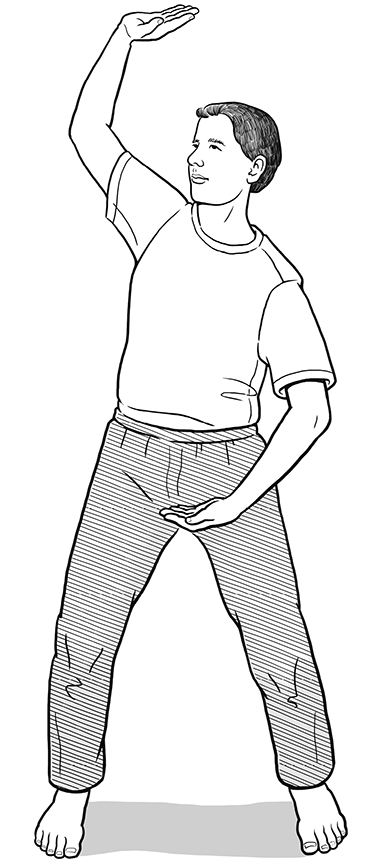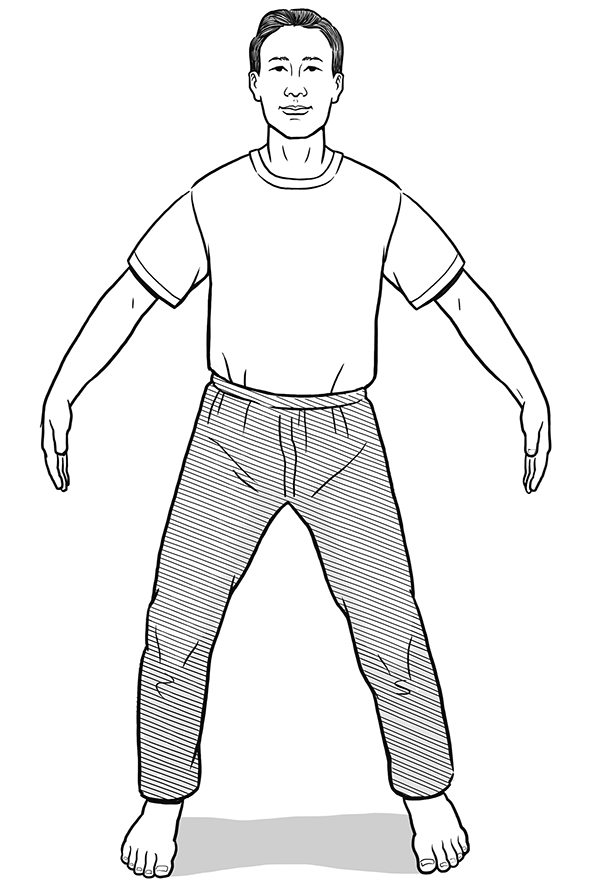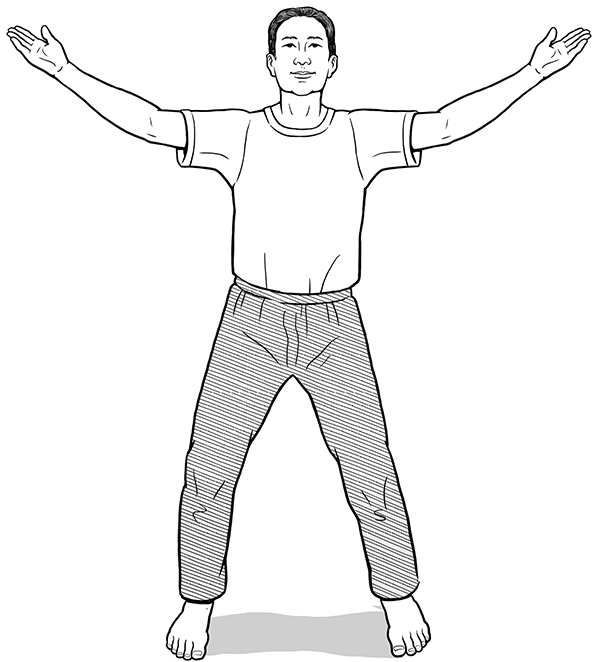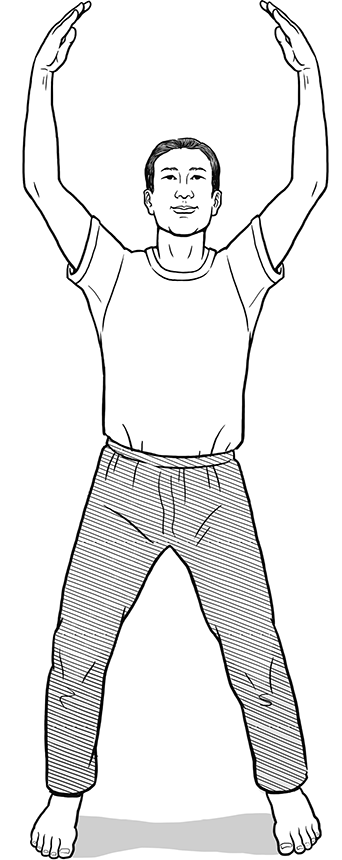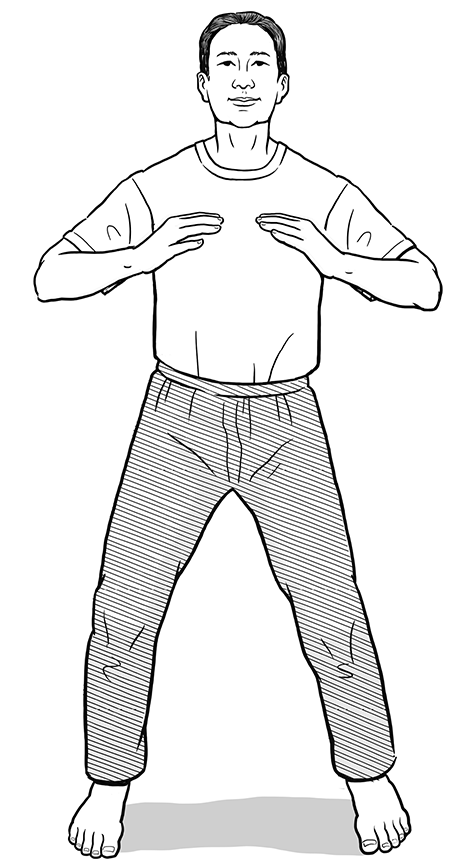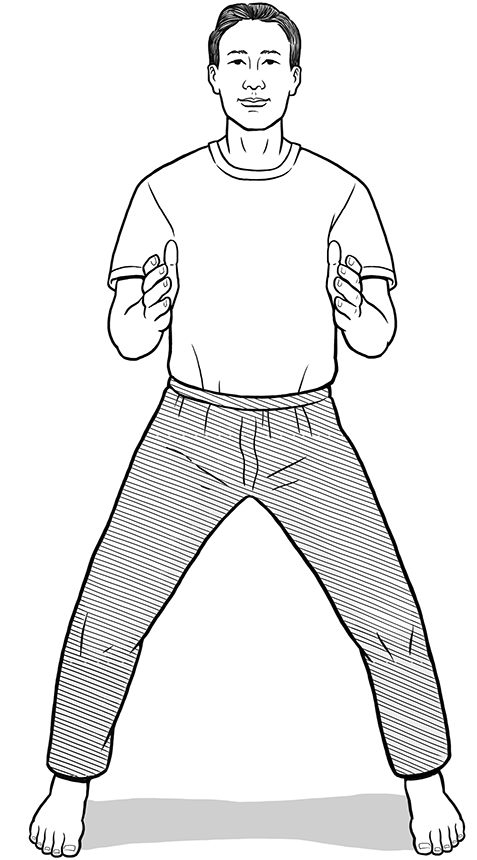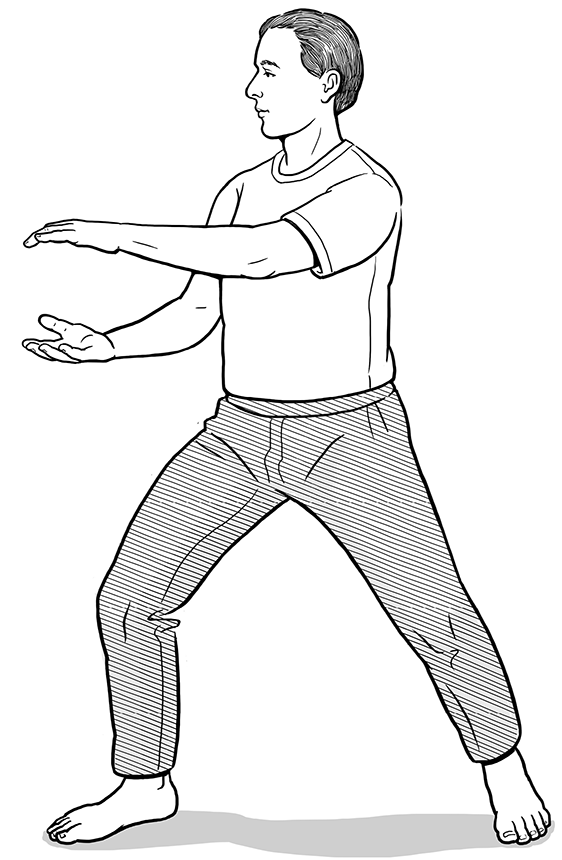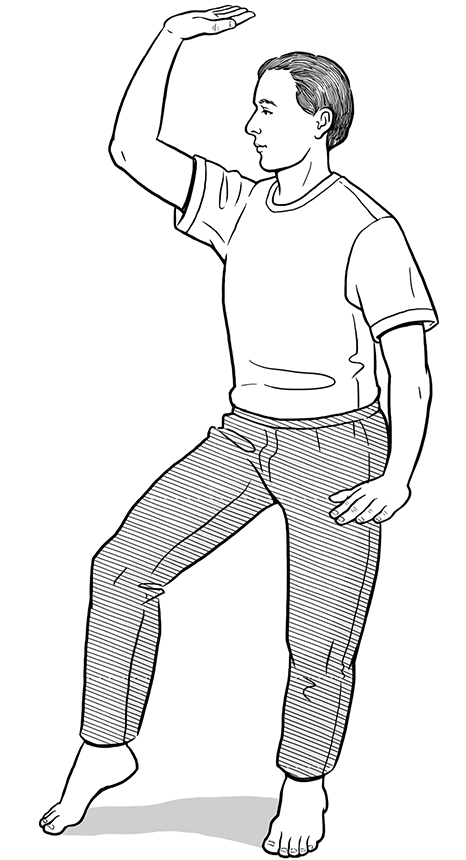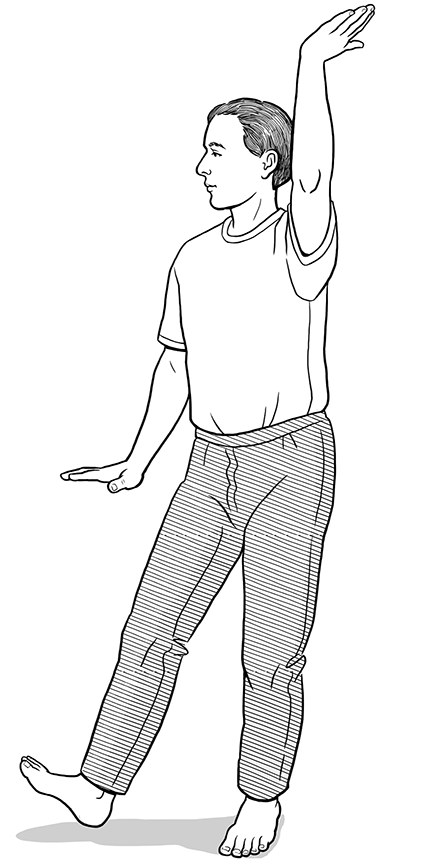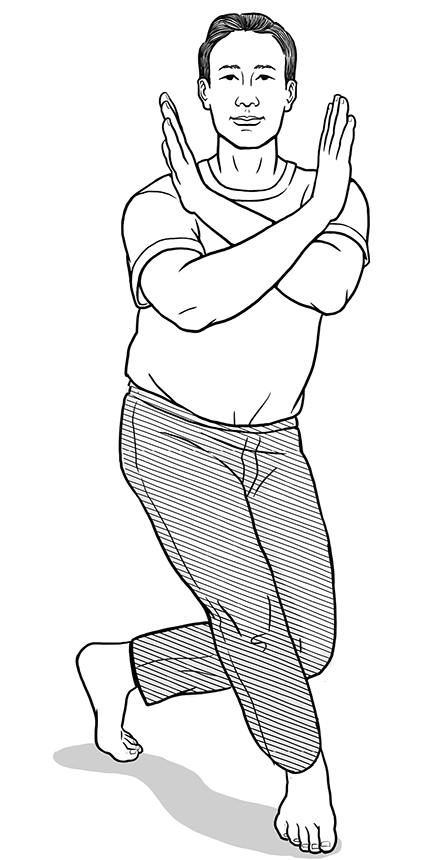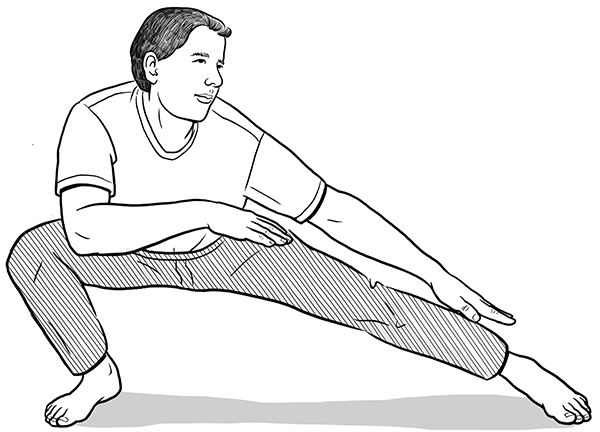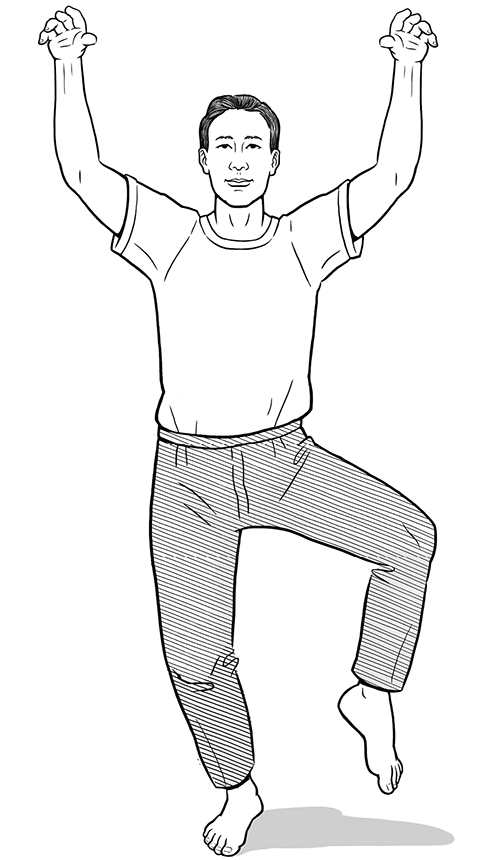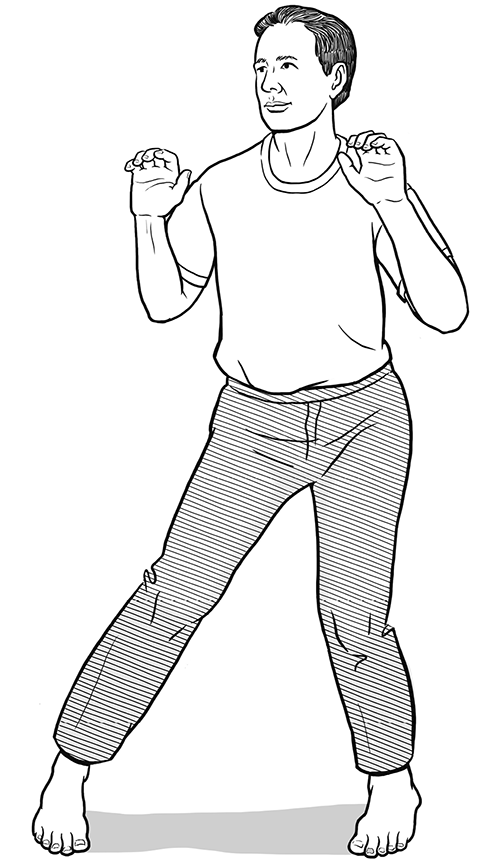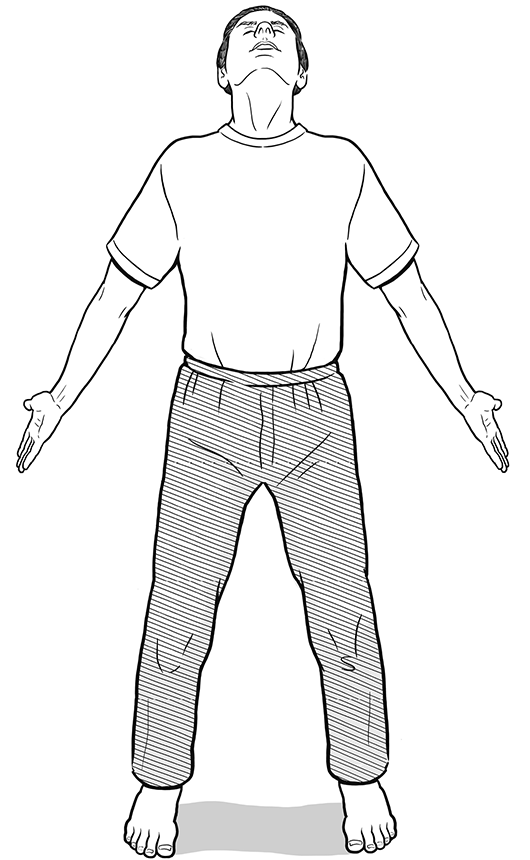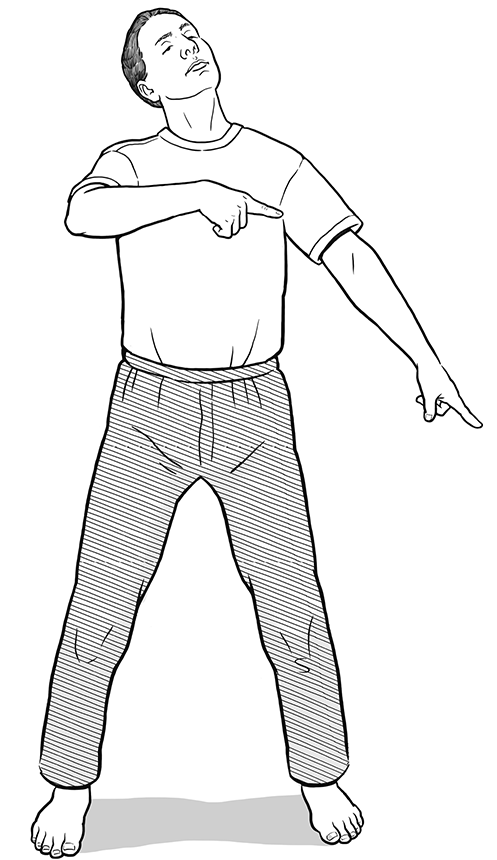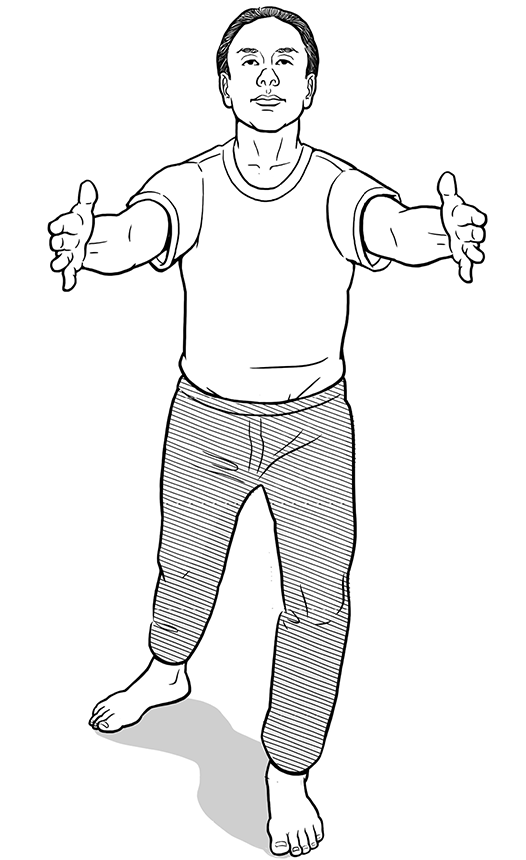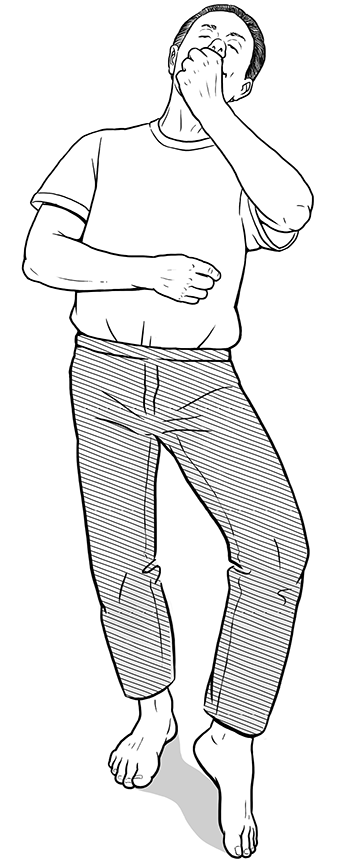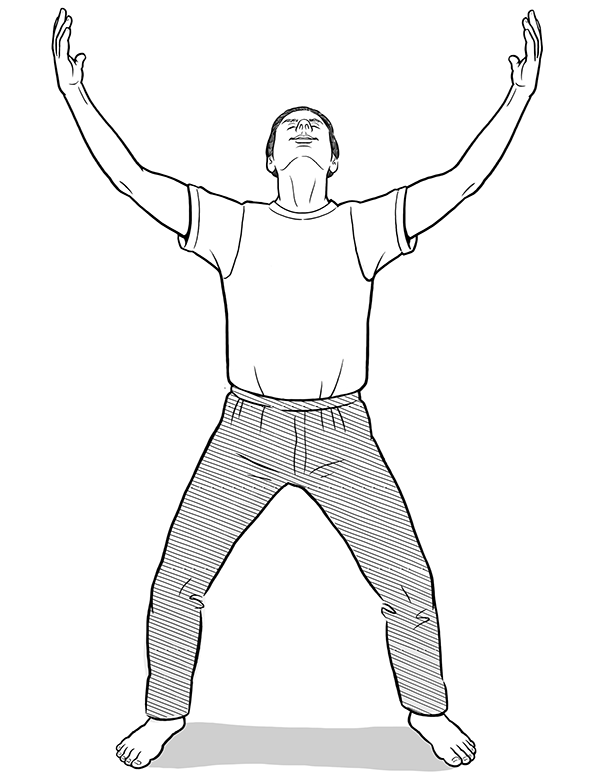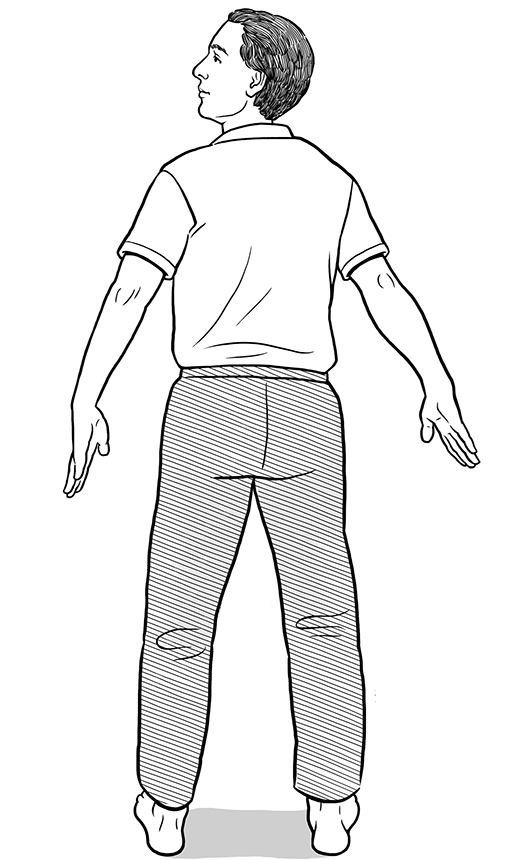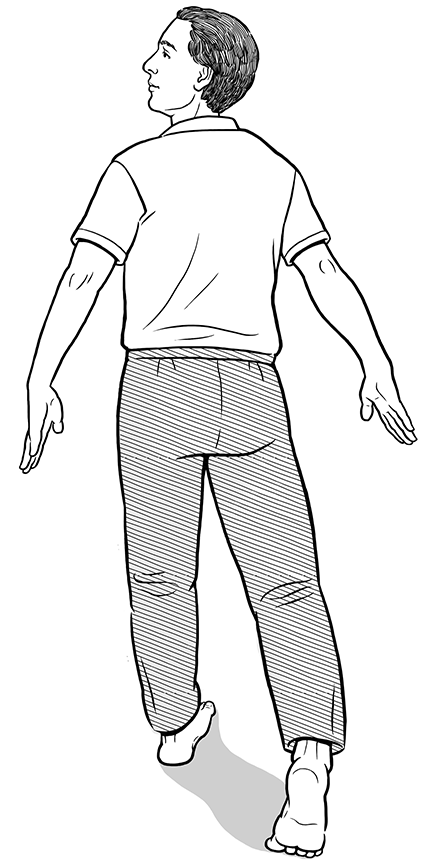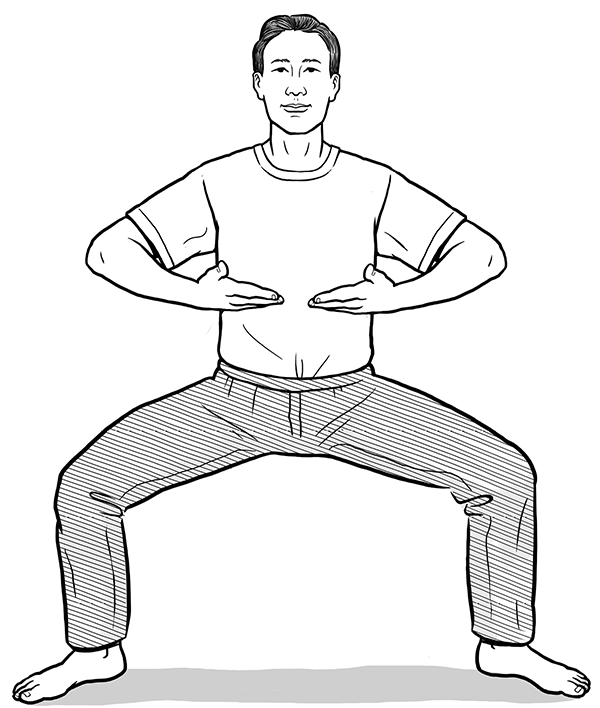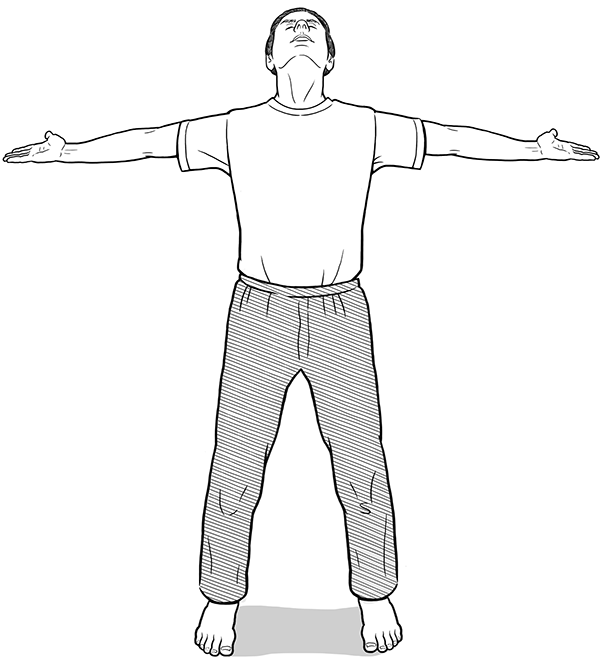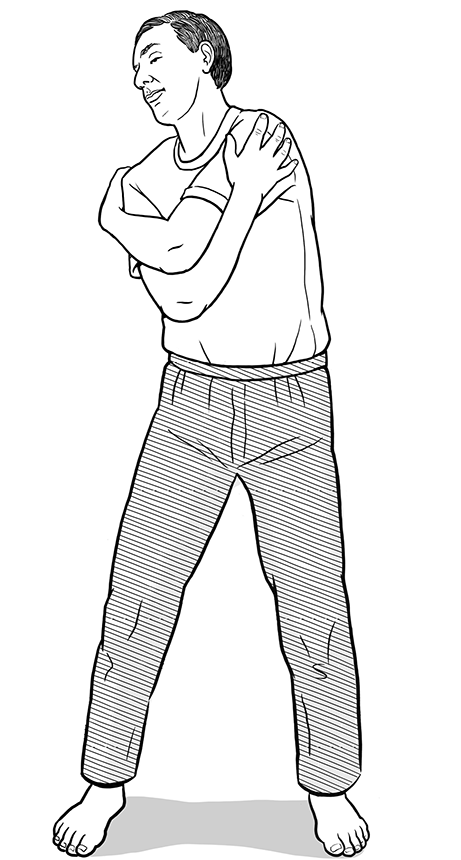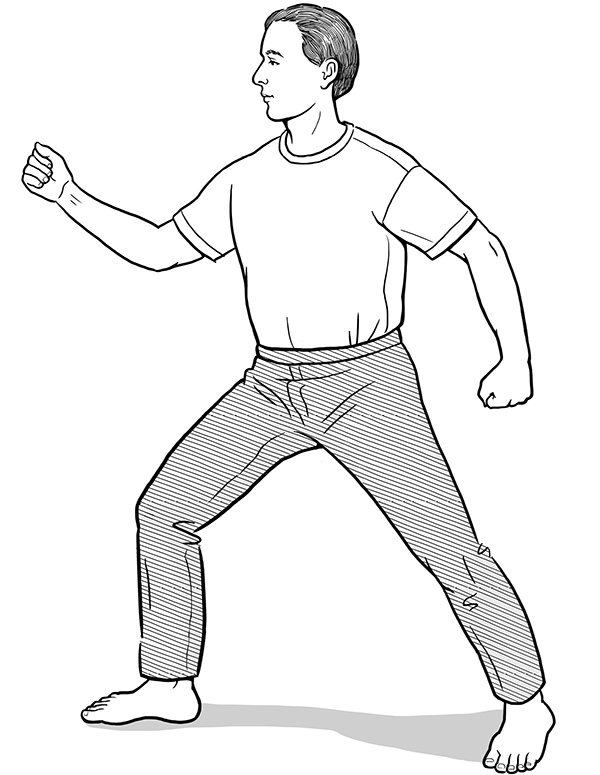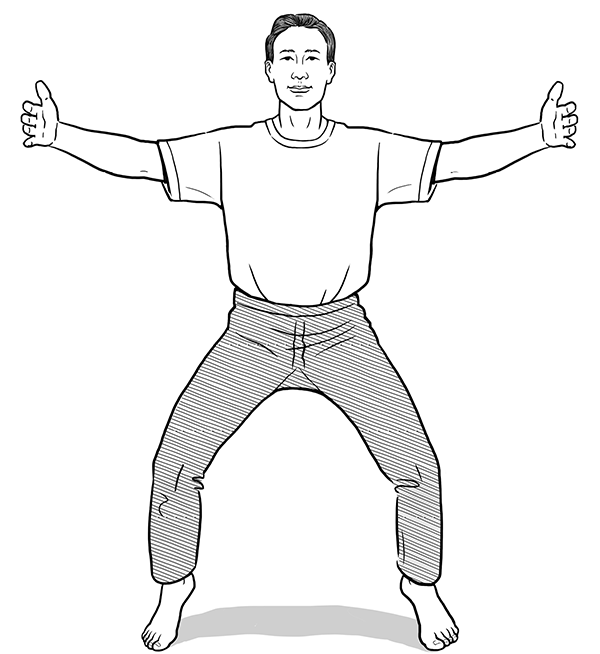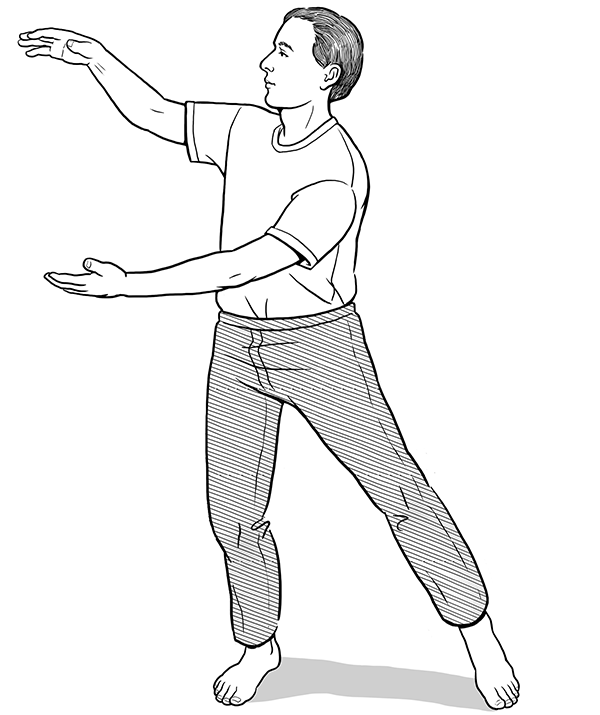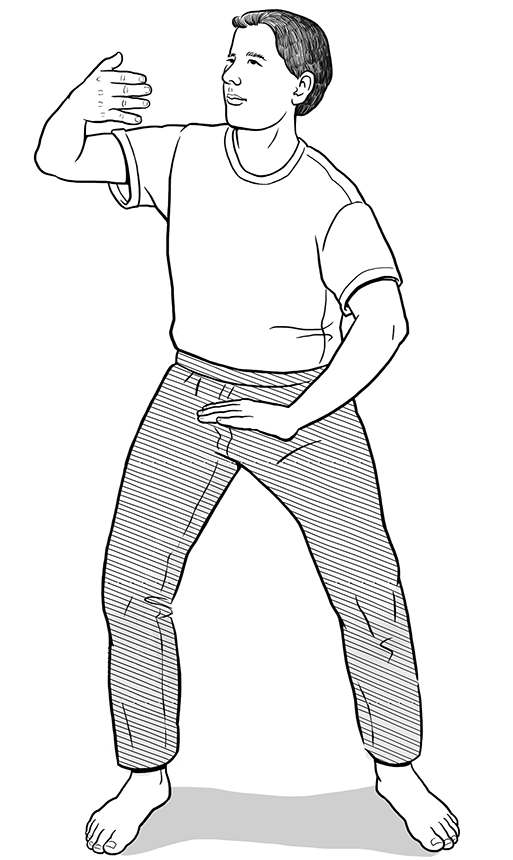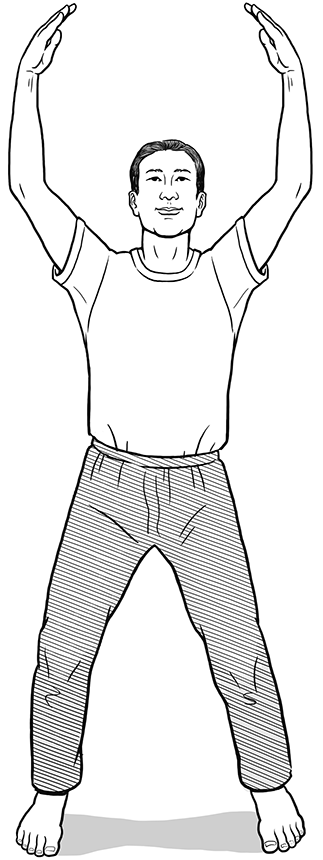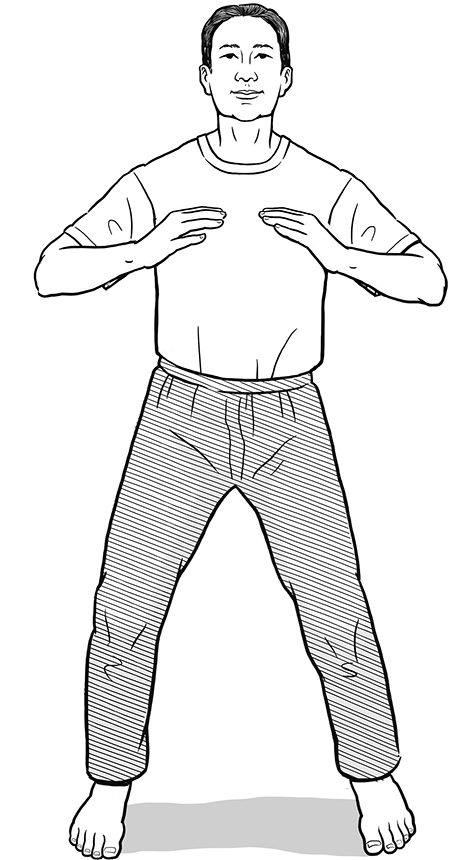Classical Movements
and Qigong Practice
In this final chapter of our journey through the pathways of qi we make our way to our feet as promised to bring our study of qi meridian energy directly to our somatic, embodied experience. Rooted in the ancient wisdom and classical practices of qigong personal energy cultivation here you will find guidance on a full practice for total health and well-being.
Classical Qi Cultivation,
Ancient Wisdom, Modern Applications
Qi is life force energy. Gong means to cultivate or to work. To practice qigong is to work with qi to cultivate the garden of life within. At the root of qigong practice are central teachings about the nature of the garden of life. The ancient Taoist sages were observers of the great vibrations of nature and the cosmos, and saw the practice of resonating with that vibration as the essence of health and balance.
We humans with our huge frontal cortex have mastered the art of objective thinking, separation, and putting things in neat little boxes. Qigong, the cultivation of life energy is ultimately the recognition of the oneness and interconnectedness of all things.
“The ultimate qigong goal is to connect directly into the force that runs the entire universe.”10 Tai chi and qigong masters know that the focused practice of these qi cultivating movements are central to self-healing. And the intention with which you practice directly relates to the benefits you will derive. Before you begin your practice of qigong it is important to ask the question, “Why do you want to learn qigong?” For you see, your intention is vital to your practice. Without a clear intention, there is no qigong.
The classical roots of qigong are deep in ancient history. It pre-dates tai chi, and itself is pre-dated by the deep mystical practices of neigong. It is a deep internal art. Walk into any modern martial art studio and watch the kicking and punching and blocking moves and you will immediately see the external martial arts in action.
The young and the new are always attracted to the external; the high and powerful kicks of Bruce Lee captivated the world. But the deeper initiation into the martial arts reveals that inside the external is the internal practice. And it is the internal practice that is most essential in the cultivation of life energy and the longevity, depth, and power of your life and practice.
A host of celebrated teachers profoundly influenced my practice and discovery of the secret and deep inner power of qigong cultivation. Deep at the root of qigong practice are a set of classical meditations, movements, and practices. These practices and the attitude and intention with which they are imbued are at the heart and soul of the health-giving
benefits of qigong. We will explore a range of classical movements and meditations and build a foundation for our practice. To deepen your ability to work with the pathways of qi, I will share with you my specialized qigong movement sequence, Meridian Gesture Qigong.
The Meridian Gesture Qigong Sequence
This sequence has been refined and crafted through my HeartMind Shiatsu training program over the last decade. It is rooted in the ancient understanding that the meridian location on the body directly correlates to the function of that meridian.
Meridian Gesture Qigong actualizes this understanding with a series of movements that articulate the meridian locations and acupoints, and stimulate qi energy flow, promoting balance and harmony throughout the meridian system.
The Meridians Gesture Qigong sequence specifically awakens, activates, and facilitates the smooth flow of qi through all the classical organ channels we have been studying. It works to clear blockages from acupoints along the way and to promote the health and balance of your internal systems rooted in your organ functions.
The body’s organs are marvelously intelligent and skilled technicians each doing their assigned tasks without the need for conscious direction or oversight. The heart beats and pumps blood, the lungs bring in oxygen and release carbon dioxide, the stomach, spleen, pancreas, and intestines ingest and digest our food and nourishment, the liver performs more than four hundred complex chemical functions to maintain our energy and internal equilibrium, the kidneys purify the blood.
Each and every organ has its place and task and performs it tirelessly, day in day out. Our conscious mind is not needed to direct this action. But one thing our conscious mind can do that goes a long way is simply to appreciate these miraculous worker bees that conduct the business of our lives.
The organs love to be bathed in appreciation, gratitude, and love. When we direct our intentions in Meridian Gesture Qigong, we are honoring and acknowledging all these deep and working parts of our being. As a result, the whole system works better.
Do you recall a job in your early career where you received praise? How did that make you feel? If you’re anything like me, it buoyed you up and made you want to do an even better job. The same is true for your internal organs. For all their complexity, they are also simple as children; a little positive recognition goes a long way.
The energy of life can be likened to a great river, continuously flowing from its headwaters to its delta at the sea. In the beginning it is gurgling and playful, jumping and bounding over boulders and rocks as it makes its way down from the mountains.
It leaps in thrilling white water chasms and waterfalls, it eddies in many a cataract and finds its way into lakes and over and under and around and through dams making its way to the broad plains where it becomes smooth and steady and flows inexorably to the sea.
Our qigong practice is much like this. We begin with warm-ups that are quite playful. As we leap over these first boulders of practice we begin to settle in, and eventually our movements slow into meditations and powerful flowing movements that flow from us internally like a great flowing river flowing unceasingly to the sea.
The energy builds up from start to end, and by the end of our practice we float upon the waves of the great ocean, deep, powerful, and connected to the great flow of life energy in the whole cosmos. As my favorite teacher Roger Jahnke once said, “Qi is the energy that keeps the earth circulating around the sun. The energy that can do that can heal your life!”
Basics of Qigong Practice
The following sequence of moving meditations form the basis of a full qigong practice. We start with warm-ups and classical qi awareness cultivation methods. We then move into Meridian Gesture Qigong. We complete with classical movements that consolidate and integrate the qi flow generated from the entire practice.
The components of a full practice that I will be leading your through are as follows:
- 1. Warm-ups
- 2. Classical qigong
- 3. Meridian Gesture Qigong
- 4. Completion and integration
1. Warm-Ups
The following warm-ups will bring you gently and fully into your practice. We will address Centrifuge, (Rapping on the Destiny Gate), Dropping the Post, Free Shaking, and Rolling Joints. You will be guided step-by-step through these warm up movements. As you practice, begin to become fully present and aware of your entire body.
Centrifuge: “Rapping on the Destiny Gate”
- • Start by standing upright with your feet slightly wider than your hips.
- • Feel the vertical line of your body from the crown of your head to the root of your torso. Feel your weight evenly balanced on both feet.
- • Begin to repeatedly turn your hips right and left.
- • Allow your arms to be slack at your sides, and let them swing as a result of the twisting of your hips.
- • Allow your arms to gently rap against your front and back body.
- • Become aware of the specialized acupoint the “Destiny Gate” that is found on the midline of the spine between lumbar 2 and 3. The gentle rapping of your arms against your body as a result of the swinging of your hips opens your “Destiny Gate.” This simple movement will have the action of freeing you up to be at your ease.
- • Play with the rhythm, making the movements bigger, smaller, faster, slower. Notice how changes in speed can deepen your sense of relaxation and freedom in your body.
- • As you are ready, wind it down, and come to stillness once more.
Dropping the Post: Jiggling, Wiggling, Giggling
- • This is a joyous exercise that can really loosen up your whole body. Practice it with a sense of joy and childlike playfulness.
- • Standing upright, first lift your heels and then drop back to floor with a jiggle.
- • Repeat many times.
- • Bend elbows, and with limp wrists jiggle your arms as you continue to drop the post.
- • Release your jaw, open your mouth, and let out some noise.
- • Alternate right and left feet, dropping the post in a jogging, jiggling motion.
- • With open mouth, stick out your tongue. Keep jiggling and then let yourself giggle. Laugh out loud in playful abandon!
Free Shaking: Progressively Shake
Every Ounce of Flesh in Your Body!
Dropping the post and jiggling and wiggling and giggling constitutes the classical set up for what we call “Free Shaking.” In the following, I guide you through a “recommended sequence” so you can really begin to shake every part of your body. The sequence has no virtue in its own right, so I hope you eventually abandon it and really let your own shaking be free!
- • Start by shaking hands, wrists, forearms, shoulders.
- • Shake hips, legs, feet.
- • Shake back, buttocks, thighs, calves.
- • Shake cheeks, jowls, head, ears, eyes, nose.
- • Shake ankles, feet, belly, chest.
- • Let everything loose, and shake from your nose to your tailbone, like a wet dog.
Rolling Joints: Opening the Energy Gates
This classical sequence does ask you to settle down from the freedom of the shaking and follow a thorough step-by-step movement through every single working joint in your body. There are vital energy gates at every joint of the body. I like to think of these gates as the hinges. The meridian pathways can be likened to canals and the joints can be seen as elevation changes along the length of the canals. At each elevation change are a set of locks ships enter to be able to move from one section of the canal to the other. Keeping these energy gates open and in good working order is vital to the smooth flow of qi throughout the meridian channels. Perform these joint rolling exercises with the purpose of opening and lubricating the energy gates, releasing any blockages that may have accumulated due to tension, stress, and poor posture.
- • Simple head nods—Start by nodding your head up and down, and feel this action all along the curve of the neck and down the spine. After going up and down several times, bring the head upright once more and then start dropping it from side to side, opening the sides of your neck.
- • Neck rotations—From side to side head nods, bring your head upright, and then drop it forward and begin making “half circles” as you bring your chin up to one shoulder and then to the other. After several half circles, move into full circle making sure to go very gently to the back. Make three full circle in each direction and then bring your head upright once more.
- • Roll shoulders—As your head rises out of the neck rotation sequence begin to roll your shoulders backward, then forward, together and then alternating right and left. Keep a smooth rotation going through the shoulders and notice any feelings of “gravel” in the shoulder joint. Move smoothly and gently to loosen this feeling of gravel in the shoulders. And as you do so, gently call to mind the many services that your shoulders do for your body, and with gratitude release any holding tension that may be present there.
- • Roll elbows—Relax your shoulders, lift your elbows up and out to the sides, and begin to sweep your forearms in half circles, and then full circles. This will release the energy gates at your elbows.
- • Roll wrists, wiggle fingers—Relax your elbows and then begin roll your wrists. Roll them back and forth and all around, changing direction many times. Then letting your wrists be still, gently wiggle your fingers.
- • Spiral Teacup—One hand at a time, hold your palm up as if resting a tea cup there. Begin to spiral your hand around over your head and under your armpit keeping your palm upright so as not to spill a drop from your imaginary teacup. This action you will find involves your wrist, elbow, and shoulder in the spiraling action, and will even spiral down your torso to your hips. Let this action be fluid and smooth, and feel it through your entire body. Change directions a couple of times, and then repeat the spiral with the second hand. Adventurous folks may want to try spiraling teacups in both hands at the same time.
- • Roll hips—From spiral teacup you will find that you are moving your awareness down into your lower body. Now bring that awareness specifically to your hips, and with hands on your hips make wide swinging circles, first one direction and then the other. At some point, slow down the wide circling, and bring the movement into pelvic tilts, forward, back, right, and left, loosening your entire pelvic girdle and promoting the smooth flow of qi through these vital joints of the body that connect your legs to your torso.
- • Simple knee bends into knee circles—Finish your pelvic tilts, and drop your hands down to your knees and begin simple, slow knee bends. After a few simply up and down movements begin to roll your two knees together in small circles, first one way and then the other.
- • One foot forward, plant big toe—Roll ankle, knee, hip—after the knee bends, stand tall once more and bring one foot forward planting the ball mounts of the toes on the ground, beginning to roll the hip, knee, and ankle, rotating down through each and every toe. Make circles one way and then the other, changing directions many times.
- • Lift one foot, balance—Rotate ankle, spread toes—If you are not certain of your ability to balance on one foot, move behind a chair and steady yourself as you lift one foot and make circles with the ankle. To get this action right, imagine that you are “drawing a circle” with your big toe, as if a felt-tip marker were on the tip of your big toe. Draw a nice smooth circle and reverse the direction several times.
2. Classical Qigong Practice
After being sufficiently warmed up, we now take our qigong deeper into our being with a series of classical practices. Honoring the Three Treasures, Radiant Heart Gesture, Seven Directions, Meditation, Plies, Wuji (in posture, breath, and mind), Small Heavenly Circle Meditation, and Stance Training all have their place in our practice, and each yield rich, extraordinary gifts in activating the qi essence throughout body, heartmind, and spirit.
Honoring the Three Treasures
The Three Treasures constitute the foundation understanding that is at the core of all effective qigong practice. And though this comes from China, and classical Taoist observations of nature and the universe, it really speaks to a universal truth, founded on a very deep common sense. The Three Treasures are called by the distinct names jing, qi, and shen, and they are all considered to be various aspects of the manifestation of life energy.
Jing is the most dense expression of life energy, and the source energy from which all springs forth. It is physical in nature and can be observed, touched, held, and manipulated directly through physical intervention. It can be considered as manifesting in our very DNA, the genetic material that has made you who you are in this lifetime in this body. The sperm and the egg are considered direct manifestations of jing, and this jing essence is the essential building block of our physical being. Closely related to jing are the fundamental substances of blood and bodily fluids. These fluid components of human life are vital to daily functioning.
Qi is more energetic in nature than jing. It is less physical though the physical is imbued with qi and we can read the quality of qi through our five senses. In a simple and direct way, qi can be compared to air. It is the medium of the atmosphere in which all life on earth thrives.
It’s notable that despite its presence, it is not something you can generally see with the naked eye. It is also found in liquid medium of water and the solid medium of rock and soil. The Chinese proverb puts it into perspective: “Fish cannot see water, humans cannot see qi.” From this you can conceive that qi is the medium in which we humans “swim.”
The third treasure is shen. Shen is the most ethereal of the three, equated with spirit, it extends through the vast reaches of space and may be discerned as light, the life giving energy that emanates from the stars and reflects off all the heavenly bodies. In human expression, we see shen in the expression of emotions, thoughts, and higher levels of consciousness.
To awaken an awareness of the Three Treasures in a very simple way, try the following movements while opening your consciousness to the three levels of being.
- • Jing—Earth, the ground beneath us. Stamp your feet, feel all that is beneath you. Gently tap your body and feel the flesh of your being. Look in the mirror and see your size, shape, gender and ethnicity, the inheritance you were born with. Feel the tissues of your body, the fluids of your body, the circulation and rhythm of blood flowing through your body.
- • Qi—The fields of life, the air that surrounds us. Twist right left, up down, back, front, and feel all that surrounds you in these fields of life. Qi exists here in the middle realm between heaven and earth, between spirit and matter. Take big, deep breaths in and out and feel the edge where air becomes a part of you on the inhale, and that which was inside you leaves you on the exhale and becomes a part of the air that surrounds you.
- • Shen—Heaven, the vast reaches of space and the light of the heavenly bodies. Sweep your arms overhead and feel all that is above you. Open your perception of the vast reaches of space and the mystical quality of all that is unseen and lies beyond common five sensory awareness.
Radiant Heart Gesture: Dancing Heaven to Earth
The Radiant Heart Gesture opens the whole body, and helps you begin to deepen into the qigong state of consciousness. This is a relaxed but alert state of being in which awareness is heightened and qi can flow optimally. Qi flows best when any unnecessary tension is removed from the body. The goal here is to do all moves with a minimum of effort. In fact, cultivating a kind of “floating feeling” is ideal. And in the end you begin to experience a kind of “non-doing” or weightlessness. With advanced experience of the work, you can arrive in a space where you seem to be observing the movements without apparently exerting any effort to do them at all. It’s as if the movements are being done through you. The famous football quarterback Joe Namath was once quoted as saying, “I don’t play football. Football plays itself through me.” This statement gets close to describing what the qigong state may feel like for you.
- • In the Radiant Heart Gesture we cultivate our awareness of yin and yang, through a felt sense of the body’s magnetic field. Below I will describe two ways of performing the Radiant Heart Gesture, one activating the yang flow and the other the yin flow. At first cultivating an awareness of the magnetic field may require a bit of good old fashioned imagination, but over time you may find that you feel a palpable quality of energy you might characterize as magnetic. To call this into your imagination, first realize that the magnetic field is real, and it does surround your body, emanating most strongly from the area of your heart.
- • Recall too that magnets are made up of the oscillation of energy between the positive and negative magnetic poles. These positive and negative energies are correlated to the jing and the shen we discussed above, or more simply as yin and yang. Yin, the negative pole, is related to the earth below us and yang, the positive pole, is related to the heavens above us.
- • Finally, the shape of a magnetic field is called a torus, which for the purposes of this exercise may be visualized to be much like the shape of a round piece of fruit. First, standing in an easy upright posture, call to mind the shape of an apple or orange, and activate your awareness of this shape as a large, luminous sphere of light or magnetism, emanating from your center and surrounding your entire body.
- • Yang: Gathering of Light—Pulling Down the Heavens—yang energy is of the heavens, and moves down through the core of the body, dispersing down into the earth. As you breathe in, sweep arms down toward the earth and out to your sides, gathering in soil, water, wind. Then continue to sweep your arms up toward the heavens and imagine that you are gathering in the light of the sun, moon, and stars. As your arms reach high above you, slowly begin to lower them down along the midline of your body as you gently breathe out.
- • Yin: Fountain of Life—Yin energy of the earth moves up through the core of your body, shoots up into the sky over your head, much like a geyser or fountain, and then disperses into the sky above and sprinkles back to the earth. Breathing in, draw your hands together up along the midline of the body and up overhead into the sky above, shooting up like a strong fountain of water. As your hands reach your full height, breathe out, sweep your hands out to the sides, and back down to the earth, wiggling the fingers like water droplets from the fountain dispersing in the sky on its way back to earth.
- • Practice alternating Fountain of Life and Pulling Down the Heavens as you twist your body right and left, sweeping arms through the entire torodial magnetic field of the body, heartmind, and spirit. Let your knees bend and straighten as you sweep your arms, creating sinking and rising movements to enhance the overall flow of qi through the luminous magnetic field of the body.
Seven Directions Meditation
The Seven Directions Meditation is a time honored practice to assist you in discovering your centerpoint. A Taoist proverb reads “At the center of every turning wheel is a point that does not move.” Finding this still point is at the core of remaining balanced in a world that is often “spinning” at a rapid pace. Please go through this practice slowly and take time at each station to open the windows of your perception to whatever may show up for you.
- • Sit quietly. Tune into your breath. Close your eyes.
- • With your mind’s eye, see all that is beneath you. Take note. Breathe in, breathe out.
- • Turn your gaze, see all that is below you. Take note. Breathe in, breathe out.
- • Turn your gaze to the right, see all that is to your right. Take note. Breathe in, breathe out.
- • Turn your gaze to the left, see all that is to your left. Take note. Breathe in, breathe out.
- • Turn your gaze to the back of you, see all that is behind you. Take note. Breathe in, breathe out.
- • Turn your gaze toward the front of you, see all that lies ahead. Take note. Breathe in, breathe out.
- • Breathe in, breathe out. Take note. Below, above, right, left, back, front …
- • Turn your gaze inward. See what is in your center. Take note. Breathe in, Breathe out.
Plies
These exercises actually derive from the ballet. Though they are not strictly taught in classical qigong methods, I have found them to be extremely effective in developing consciousness of the body in motion. They serve the purpose of enhancing personal awareness of your centerpoint while in movement, and for establishing a deep felt sense of alignment in the bones and joints and coordination of the muscles of the hips, knees, ankles, and feet.
Standing upright, squeeze the muscles of the buttocks to create a lateral rotation of the femur in the hip socket. This is known as a “turn out” in ballet. You may recall seeing ballerinas walking with their feet turned out, instep facing forward. But what is important to note here is that the turn out needs to start in your hips and the feet must not be turned out further than the hips. The goal is to laterally rotate the femur and then bring the knees, ankles, and feet in alignment with that rotation, not further.
The plie is then performed by bending the knees to lower your center of gravity, while keeping the torso upright. Take care to bend the knees out directly over the big toes or even middle toes. This alignment is critical and will help you maintain proper alignment, tone, and integrity of the lower body, an essential component in the art of balance.
There is an entire series of standing ballet exercises that can be used in enhancing your qigong standing practice. For its part, the plie is the core method with which you need to become familiar. As you continue through the standing exercises below, continue to pay close attention to the alignment of hips, knees, and ankles in all your movements and postures.
Wuji: The Mother Posture of Qigong
You’ll recall that in our study of yin and yang we quoted the proverb: “One, the universe divided, becomes two, yin and yang, opposites that make the whole.” Well, wuji is the “one” in this quote; the “whole.” Yin and yang are the two parts of the tai chi, the “great chi” often translated as the “great ultimate.” Yin and yang are contained within wuji. And at the same time, wuji represents the full undifferentiated wholeness before the division into yin and yang.
And so, wuji is the primordial, undifferentiated, ever-present energy of the universe. It is the source and the essence of all things manifest and potential. It is oneness. It is non-dual. Practicing the posture, we practice melting/dissolving into the non-dual.
It is a standing meditation, that is profound in its application, scope, and impact. In traditional qigong training, it is my understanding that this is the only exercise practiced in the entire first year of training. Imagine not learning any other exercises to practice for one whole year but standing still!
In your standing still, you will note three areas of focus: your posture, your breath, and your mind. Start with posture, then bring in the focus on your breath, and finally watch your mind. Take your time. There is nowhere to go, nothing to do, nothing to achieve, nothing to prove, no one to please. Simply drop in, and breath by breath, move yourself deeper into stillness.
Wuji—Postural Awareness
- • Stand with your feet just wider than your hips.
- • Parallel your feet, as if you are wearing cross-country skis, with the skis in parallel tracks.
- • Gently bend your knees, aiming them directly out over the middle toes.
- • Feel your tailbone sink toward the earth. If a line were dropped down from your tailbone it would touch a spot exactly in the center between your two feet.
- • Feel “marionette strings” attached to your elbows pulling them up and out to the sides. Hands will face obliquely toward the back.
- • Feel your spine rising up to the heavens. The back of your head lifts, your chin tucks in slightly.
- • There is a gentle lifting in your sternum. Your belly is relaxed and open.
- • Allow the tip of your tongue to rest on your top palate behind the top teeth. Eyes are just barely open or gently closed. Focus inward.
Wuji—Breath Awareness
- • Standing in the posture of wuji, turn your attention to your breath.
- • Follow the breath down into your inner body.
- • Imagine that your body is like a balloon. The inhalation enters, fills the center, and from there expands out in all directions. The exhalation relaxes, and the balloon shrinks back to the center.
- • Slow the breath down to “turtle’s breath”—four cycles per minute.
- • Practice “six-sided breathing.” From the center, expand the torso front and back, right and left, top and bottom. Creating space for all the internal organs. Recall your practice in the Seven Directions meditation to enhance your experience of this breathing awareness.
Wuji—Mind Focus
Let the mind be as the sky and the thoughts and feelings as the clouds. Just as the sky does not cling on to the clouds, your mind need not cling on to your thoughts and feelings. Allow the thoughts and feelings to float through your mind, like clouds through the sky. Sometimes the sky is full of clouds, sometimes it is clear and blue. Be not concerned, let the thoughts and feelings be and follow none of them, just let them come and go.
Small Heavenly Circle Meditation
The Small Heavenly Circle meditation is also known as Microcosmic Orbit. It is an ancient Taoist meditation that has been handed down for generations. It is particularly focused on opening the two central vessels of the body. These vessels are two of the eight extraordinary vessels and are the only extraodinary vessels that have acupoints of their own. The remaining six vessels all use points along the regular channels, interconnecting the system from superficial to deep. These two central vessels begin at the perineum, the midpoint between the genitals and the anus at the bottom of the torso. One vessel runs up along the midline of the front body and ends at the lower lips. We call this the Sea of Yin. The other runs up along the midline of the back body, over the crown of the head and down the forehead through the nose to end at the upper lip. We call this the Sea of Yang.
Much like meridians, these vessels run right through the centerline of the body and have acupoints of their own. Of note though, these are not considered to be regular channels. As we discussed earlier, these vessels connect us deep into the constitutional layers of health, and can be used to great effect to tap into the very origins of life itself. A helpful analogy to draw between meridians and vessels is to think of rivers and reservoirs. The meridians are like rivers, and the vessels are like reservoirs. In times of flood, we fill the reservoirs so that we might have a resource to draw upon in times of drought.
Your extraordinary vessels are the reservoirs of your constitutional qi, your original endowment of life energy. As such they are the place you can go to to draw strength in times of difficulty, and to connect to the reason and purpose for your life. The Small Heavenly Circle meditation gives you access to the source qi as it manifests in these two “extraordinary” midline vessels, and as such can be seen as a primary tool in the work of self-healing.
One more note to take to heart, the front vessel is known as the conception vessel and we recognize it as the Sea of Yin. All the yin energies of the body can be connected into this vessel. And the back vessel is known as the governor vessel, the Sea of Yang. Here all the yang energies of the body can be accessed and addressed. And so, the Small Heavenly Circle meditation serves to balance yin and yang in the body and in your life. Follow along these vessels and their major points as you open the awareness of qi energy flowing through the seas of yin and yang, promoting inner balance and and deep harmony within you.
- • See a bright pearl of light at the third eye yin tang point between your eyebrows. Build the energy and light there.
- • Draw the pearl of light down the bridge of your nose, into the tip of your tongue, down your throat and into your heart center. Let the energy and light build there.
- • Draw the pearl down from your heart center along the midline of the front body, past the navel into the lower abdomen, the lower t’an t’ien, your “energy ocean” or “elixir field.” Let the energy and light build there.
- • Continue to stream the energy down the front midline from the third eye to the t’an t’ien.
- • From t’an t’ien, draw the pearl of light down to the root chakra at the perineum, midway between the genitals and the anus.
- • From the root, draw the pearl of light back to the tailbone.
- • From the tailbone, draw it up the midline of the back body, to the ming men, “destiny gate,” Governor Vessel 4, between the lumbar vertebrae 2 and 3.
- • Continue to draw it up the spine to the back heart, to the base of the neck, base of the skull, and then up to bai wei, “meeting point of one hundred meridians,” GV 20, at the crown of the head.
- • Feel the energy bright and strong at bai wei and draw it forward to connect once more with yin tang, the third eye.
- • Having completed one full circle, now continue, circulating the energy down through the midline of the front body, and up the midline of the back body. Repeat over and over.
Stance Training: Building Stability,
Strength, Endurance, and Courage
Stance training takes what you have learned from plies and the wuji posture and amplifies this practice into a full body discipline that will yield incredible benefits for you in the areas of strength, stability, balance, endurance, and courage.
This exercise sequence can be quite intense; you should allow yourself a chance to gradually work up to its full expression. At the same time, monitor your own level of readiness for this practice. At first you may only hold each posture for one or two breath cycles. Gradually you can lengthen the amount of time you spend in each position, up to eight minutes for each.
Depending on your available time for practice, you will need to watch the clock and determine how this sequence fits into your overall practice. It can be used interchangeably with the Meridian Gesture Qigong sequence. Yet it also complements that sequence. You will see a great deal of overlap and redundancy between these sequences. This repetition is intentional and purposeful and will ultimately deepen your practice overall.
- • Horse Stance—base posture: This is basically wuji posture but a little wider and with the image of riding horseback.
- • Forward Stance—right and left: A classic 60/40 stance, hips squared to front foot. Front leg bent, back leg straight. Come back to horse, repeat to other side.
- • Toe Stance—right and left: All weight on one foot, hips turned 45 degrees toward unweighted leg. Toe of unweighted leg touches the ground with knee bent. Come back to horse, repeat to other side.
- • Heel Stance—right and left: All weight on one foot, hips turned 45 degrees toward unweighted leg. Heel of un-weighted leg touches the ground, this leg is completely straight. Come back to horse, repeat to other side.
- • Cross Stance—right and left: All weight shifts to one foot. The other foot sweeps behind, crossing over the midline. Ball mount of rear foot accepts half the weight. Bending knees, the rear knee aims toward front foot. Come back
to horse, repeat to other side.
- • Deep Stance—right and left: Place all weight on one foot while bending knee and dropping center of gravity low. The other foot slides out away from the midline as far as possible, into this deep stance. Arms swing out over extended leg. Switch sides with a “ki-ai!” yell, straightening the bent leg, and bending deep to the other leg, swinging the arms in a full arc and out over the extended leg on the other side. Repeat several times. End in Deep Horse.
- • Standing White Crane—right and left: Standing on one leg, the arms lift up wide over the head, as the knee of the un-weighted leg rises, toes pointed toward knee of standing leg. Gaze straight ahead. Lower arms and leg together. Then raise arms and lift the second leg. Repeat going from side to side in rhythmic fashion.
- • Bear Stance—right to left: Feet comfortably parted, just wider than hips, turn them inward or pigeon-toed. Sink your weight onto one knee, bending that knee and turning your hips 45 degrees toward the unweighted leg. Come up smoothly and shift to other side. Hold hands like bear paws in front of the chest at shoulder height.
3. Meridian Gesture Qigong
Before I guide you through the Meridian Gesture Qigong sequence, it is good to recall once more the sequence of the one meridian flow, and review each of the meridian starting and ending points. Fresh from this review, we will get right into the qigong gesture for each meridian.
Circadian Rhythm: Meridians and the 24-Hour Clock
- • Lung, 3–5 am; Large Intestine 5–7 am;
- • Stomach 7–9 am; Spleen, 9–11 am;
- • Heart, 11 am–1 pm; Small Intestine, 1–3 pm;
- • Bladder 3–5 pm; Kidney, 5–7 pm;
- • Pericardium, 7–9 pm; Triple Warmer, 9–11 pm;
- • Gall Bladder, 11 pm–1 am; Liver, 1–3 am.
Classical Trajectory Overview
Where one channel ends, the next begins nearby, creating one continuous flow:
- • Lung begins just lateral to the second rib and ends in the thumb.
- • Large Intestine begins in the index finger and ends at the nose.
- • Stomach begins at the eyes and ends at the second toe.
- • Spleen begins in the big toe and ends in the side ribs under the axila.
- • Heart begins in the axila and ends in the pinky finger.
- • Small Intestine begins in the pinky finger and ends at the ear.
- • Bladder begins at the eyes and ends at the pinky toe.
- • Kidney begins in the bottom of the foot and ends at the clavicle.
- • Pericardium begins outside the breast and ends in the middle finger.
- • Triple Warmer begins on the ring finger and ends at the eyebrow.
- • Gall Bladder begins at the outer eye and ends at the fourth toe.
- • Liver begins on the great toe and ends in the ribs just under the breast.
- • Lung begins on the chest just lateral to the second rib …
Meridian Gesture Qigong
The HeartMind Meridian Gesture Qigong sequence follows the daily cycle of energy flow beginning with Lung and working through each meridian in sequence to Liver. This sequence affirms the flow of the one meridian and its many points and facets in the twelve organ networks of the body. It is firmly rooted in the classical understanding that once you know the function the organ network performs you can nearly predict where the meridian line will be on the surface of the body. And as you accentuate that line on the surface of the body you are activating and supporting the smooth flow of qi in that meridian system to maintain and sustain its optimal functioning.
The gestures of the meridian channel aspects that follow are the foundation movements and mindset of the Heartmind Meridian Twelve Qigong sequence, especially developed to open and stimulate the life energy in the one meridian and its twelve channels to increase consciousness, healthy balance, and flow.
The Lung Channel Gesture
As you strike a pose that stretches all the points along the Lung channel from the pectoralis muscle to the thumb, you will see that this pose deeply and directly relates to the movement of breath in and out of your body.
- • Start in the wuji posture. As you exhale, slowly fold forward, bending your knees, shifting your belly back in space, dropping your head, and bringing your hands forward almost touching thumbs together at the midline.
- • Breathing in, slowly rise up with thumbs leading the hands and arms out to the side and behind you. Open your chest skyward and stretch your thumbs to the back. This position stretches the entire Lung meridian, and as you perform it you will find that you automatically take in a large breath filling your lungs with air.
- • After stretching fully open, slowly reverse the action, exhale, close down your chest once more, drop your head, and nearly touch your thumbs together in front of you.
- • On the next inhale, open once more, and on the exhale, close to the front.
- • Repeat the entire exercise several times.
- • On the inhale; breathe in white, the pure qi of the universe.
- • On the exhale breath out all your gray, murky qi that you no longer need. Breathe out your sorrow and loss. Give it back to the universe.
- • Let this gesture build your awareness of the breath, the most basic fundamental rhythm of the body, heartmind, and spirit. Shower your lungs with gratitude and unconditional love.
The Large Intestine Channel Gesture
When you strike a pose that stretches out the entire flow of this channel, you find yourself pointing down to the ground with the index finger while at the same time lifting your nose up to the sky. This is a posture you might assume if you were pointing down at a malodorous pile of matter that had clearly just emerged from some animal’s large intestine. This follows right after the Lung gesture, in the Meridian Gesture Qigong sequence.
- • As you stand tall on the last exhale of the Lung gesture, make light fists and point both index fingers down toward the ground.
- • Slowly shift your hands to point down to the left. The left index finger particularly points strongly down to the ground, as if pointing at a dung pile.
- • The right index finger then points toward the left index finger, and draws a line up along the Large Intestine meridian line from the index finger to the nose and beyond.
- • Point the right index finger strongly toward the heavens, while the left index finger continues to point to the earth. Repeat the affirmation: “I graciously let go of that which no longer serves me.”
- • Sweep the right hand now down toward a dung pile on the earth off to your right, and let the left index finger sweep over and draw the line up along the Large Intestine meridian line on the right arm, from the index finger to the nose and beyond.
- • Sweep it up and out toward the heavens, and point it down again at the left side.
- • Repeat this sweeping gesture many times to each side. Affirm the Large Intestine in its task of letting go of all that you no longer need.
- • Return to wuji posture and feel the benefits of the movements.
The Stomach Channel Gesture
As you strike a pose that activates this entire channel, you will find that you are much like a picture of a hunter-gatherer warily stalking your prey. The classic Meridian Twelve Qigong movement is drawn from the yoga posture of Warrior 1 and speaks to the strong energy that governs the essential function of appetite in our human life.
- • From wuji, shift your weight smoothly onto the right foot and lunge forward with the left foot.
- • Turn your right foot to 45 degrees keeping the right leg straight.
- • Square the hips forward toward the left, with left knee bent. Bend forward at the hips, bringing the hands down along the left leg to the left foot.
- • Sweep your hands out in front of you, and stretch out through your arms as you slowly raise your torso to an upright position, with your arms projecting overhead in line with your ears. Your left leg remains bent, right leg straight forming a strong foundation for what is known in yoga as the Warrior 1 posture.
- • As if holding something between your palms, bring them down to trace the Stomach channel from face to throat, to chest, to belly, and then forward bend down the leg to the foot, and sweep out to the ground in front of you once more.
- • As you raise your arms this time, imagine that you are growing a tree from the roots up the trunk to the branches to the fruit. Then you are harvesting that ripe fruit and bringing it down to nourish your whole being, head, heart, and hara (center).
- • Sweep down the leg a third time, and repeat the entire gesture.
- • After stretching tall, bring the energy between your palms down to the heart level and switch your feet. Repeat the gesture three times on the second side.
With each of the sweeping gestures, imagine pulling that which you want and need down through the Stomach meridian channel. Note how the channel flows through the head, the heart, and the belly. It is nice to think of these as the three stomachs, for indeed we have appetite in all three areas: intellectual, emotional, and physical. And all appetite is the domain of Stomach channel. Enjoy this gesture with all the gusto you can muster.
The Spleen/Pancreas Channel Gesture
Spleen/Pancreas is all about nourishment, sweetness, and goodness. If you strike a posture that articulates this entire channel you will find that your body takes on an aspect that is provocative and inviting, holding the promise of sweet nourishment. To practice the movement that supports Spleen function, do the following:
- • From wuji, step your feet slightly wider and turn out your hips, knees, and feet about 45 degrees.
- • Sweep your arms up and out to the sides and down toward the ground.
- • As you sweep toward the ground, plie at the knees, and bring your left hand to the earth as if to pick a ripe strawberry.
- • Rise up, bring the “strawberry” to your mouth while shifting your weight onto the right foot, and bringing your left foot forward, presenting the Spleen channel from the big toe up to the breast.
- • With your left hand at your mouth, enjoying the strawberry, let your right hand rub your belly in a clockwise direction.
- • After a moment, sweep the hands up, out, and down once more. Return the feet to a plie to descend easily to pick another strawberry.
- • This time, use your right hand to bring the strawberry to your mouth. Let the left foot take your weight and bring the right foot forward to present again to the Spleen.
- • Enjoy flowing from right to left repeatedly each time deepening the sweet feeling. Let yourself connect to a “happy for no reason” feeling, and be aware that balance
is required for this movement just like it is in the regulation of the rise and fall of blood sugar.
The Heart Channel Gesture
This gesture should be performed in slow and flowing movements to fully activate the heart channel. As you practice, you may recall the posture of those praising God or the spirit world with the uplifting feelings of love and joy.
- • From wuji, allow the backs of your hands to float toward one another, in front of your hara.
- • Slowly draw them up the midline of your body, passing the heart center, the throat, the third eye, and rising above your head.
- • Slowly open them out to the sides, palm up, while gazing heavenward with a slight backward tilt of your head, holding a golden ball of qi overhead.
- • Begin to turn right and left, twirling the qi ball above your crown.
- • After a time of twisting right and left, turn to face front and raise your palms directly over your head as if they were showerheads showering a deep red light down onto your crown.
- • Bring your gaze to horizontal, bend at the knees, sink down toward the earth, and feel that deep red light flowing from your crown down to your feet.
- • After several breaths, gradually turn your palms toward the heavens once more, leading with the pinky fingers, like a lotus flower blossoming under the sun. Expand your chest and arms feeling that you are connecting with the vastness of the entire universe.
- • After several breaths, slowly sweep your hands down toward your sides and pause, feeling the energy of the Heart channel activated and coursing through your being.
- • Let the pause be dynamic as you flow continuously into the Small Intestine gesture.
The Small Intestine Channel Gesture
Taking a look at the entire meridian from the first to the last point, we make the gesture of knifing the hand and arms down through space until bringing them alongside the body, turning the head to look back over one shoulder. When seen from behind, this gesture will expose the entire surface of the meridian channel. And the mental focus of the gesture should carry the quality of communicating the statement, “Get back!” or to quote scripture, “Get thee behind me!” The Small Intestine must separate the pure from the impure, and this gesture shows how the surface trajectory of the meridian and the actions of the muscles through which it runs serves to support and illustrate that function.
- • Filled with the bright red light of the heart your hands find each other palm to palm in front of your root chakra.
- • Slowly raise your hands, elbows extended, as if lifting out of a swamp.
- • As your arms reach heart height, allow your elbows to bend, bringing your thumbs to your forehead.
- • Look skyward and lean gently back in space, “praying to heaven to show the way.”
- • Finding your truth, come back up standing tall. Gazing straight ahead as you knife your hands forward and down, karate chop edge of your hand leading the way.
- • Let your knees bend as you knife forward decisively, hands to either side of your hips, pinky fingers extended behind you.
- • Stand tall once more, as you turn your head to look over one shoulder. Breathe out completely.
- • As you breathe in look ahead once more, bring your hands back together at the root and repeat the movement up to your forehead and a slight backbend.
- • Knife forward once more, exhaling. Bend the knees as the hands go to either side of your hips and stand tall, looking over your other shoulder.
- • Repeat this several times, and the last time bring your hands forward to palms press earth and pause there a moment and then move smoothly into the Bladder meridian flow.
The Bladder Channel Gesture
To strike a gesture that activates the entire Bladder channel, and illustrates a central feature of its functional range, bring your hands up in front of your body, palms facing the earth. Then swing your hands down along your sides while taking a powerful step forward with one leg, thrusting forward from the midsection of your body. The back heel will come off the ground, articulating the leg all the way down to the pinky toe. To complete the entire gesture, turn your head to look back over the hind foot. As you practice this movement, you will be connecting the entire Bladder channel from Bright Eyes to Extreme Yin. As you do so, say to yourself, “I am driven forward to achieve but I keep an eye on my back!” A strong affirmation that underlines the time honored truth that those who do not learn from the past are doomed to repeat it. Much of the Bladder meridian’s functional range can be related to this task.
- • With palms pressing earth, shift your weight onto your right foot.
- • Step back with your left foot turned inward, in 60/40 stance.
- • Shift your weight onto the right front foot once more, sweeping your hands back to either side, and letting your left heel come off the ground.
- • Turn your head to look over your right shoulder, twisting as far as you can, as if you could turn and look at your left pinky toe.
- • Breathe out completely.
- • As you breathe in once more, look front, bring your hands back to palms press earth, and step your right foot back to meet your left.
- • Step forward with your left foot, thrusting from your midsection, arms sweeping back to either side again as you shift your weight forward onto the front foot. Your right heel comes off the ground and you turn and look over your left shoulder.
- • Step back with the left foot as the hands come forward again to palms press earth. Repeat the affirmation “I drive myself forward, keeping an eye on my back.”
- • Thrust forward with vigor each time.
- • Repeat, alternating sides, many times.
- • When complete, sweep arms up and out to the sides, step wide with feet turned out, ready to begin the Kidney gesture.
The Kidney Channel Gesture
The Kidney channel flows up from the bottoms of the feet to the groin, and from the pubic bone to the clavicle quite near the front centerline of the body. It accesses and governs the deep and personal aspects of libido, procreation, vitality, and ancestral energy that is handed down through the generations. It’s position deep in the feet and legs, and moving through the groin and onto the front of the body is auspicious and appropriate. The yoga posture known as Reclining Bound Angle pose is a perfect posture for balancing and activating the Kidney channel. In our standing Meridian Gesture sequence we stay on our feet and perform the following Fountain of Life gesture.
- • Take a wide stance, with your feet turned out over your big toes.
- • In this deep knee bend, sweep your arms down and begin to “gather” the deep yin energies of the earth, as if you were playing in mud or forming clay.
- • Continue to shape this clay as you begin to raise the hands up, feeling this earthy energy a deep blue/black, coursing up from the bottom of your foot, through the instep, to the inner ankle, back of the calf, back of the knee, and deep in your thigh from knee to groin.
- • As your hands rise to your torso, straighten your spine to an upright posture, keeping a gentle bend in your knees.
- • Bring the energy up through your torso, as if filling up from below. Pause at each chakra center and imagine it is being filled up.
- • Fill the root, sacrum, solar plexus, heart, throat, third eye, and crown.
- • As your hands pass beyond your crown, open them overhead as in the Heart gesture, and deepen your knee bend.
- • Feel the red light of heaven descending and joining with the blue/black of earth, forming a royal purple color in your heart.
- • Deepen the knee bend as you hold your hands to the heavens. Join the jing of Kidney with the shen in the Heart, unifying yin and yang, earth and heaven.
- • Sweep your hands out to the sides and down to the earth to gather once more.
- • Repeat three times, and on the last sweep, let the hands rest on your knees and shift weight side to side, building deep strength in the lower extremities.
- • As you practice the actions, repeat the words “I feel the vital life force that flows deep within me.” With this movement you can positively activate the Kidney channel, filling up your deep center with vital energy.
The Pericardium Channel Gesture
Taking the entire meridian length into view, from the breast out through the biceps to the palm of the hand, one can seen the inside circlet of the embracing arms. Here the shared warmth of the heart is demonstrated, a perfect illustration of the meaning and purpose of this meridian in our lives, promoting circulation, shared warmth, and emotional protection. Use the following movements to open the entire channel and energize its function. In the complete sequence, this follows directly after the Kidney gesture.
- • Standing up from the deep stance of Kidney, slowly walk your feet together with a toe-heel movement, and bring your palms together in front of your sternum or heart center.
- • Pause here a moment and return to oneness. Feel your heartbeat.
- • Raise the elbows out to the sides, pressing the hands together more firmly.
- • Turn the fingers to face the front and while continuing to keep pressure between the palms, extend the arms out as far as they will go in front of you, keeping them at shoulder height.
- • Drop the chest in and back, and feel your shoulder blades stretch and open up, pulling away from the midline of your back.
- • Leading with the fingers, bend the hands back and open them away from one another, slowly but surely opening the arms out to the sides and back in space while keeping them at shoulder height.
- • Lead this movement with the middle finger, stretching the palm of the hand as you do so.
- • As your arms widen out to your sides, you’ll notice the chest naturally opening and expanding forward and a deep breath coming into your chest.
- • Continue to move your arms back in space, keeping the hands at shoulder height.
- • Stretch back, as if you could touch your middle fingers together behind you.
- • Gently lift your gaze heavenward, and hold the stretch for a few breaths, affirming that you open your heart to all the gifts that life has to give you. Let your chest move forward and then your hips, taking yourself into a deep opening stretch.
- • Then as you exhale, slowly return your torso to upright, and begin to sweep your hands forward. This leads directly into the Triple Warmer gesture.
The Triple Warmer Channel Gesture
To articulate the entire Triple Warmer channel we perform the gesture known as the Bear Hug Twist. It follows neatly after the Pericardium gesture.
- • After the wide heart open stretch position of Pericardium, your arms slowly drift forward in a large arc as if you were hugging a large tree.
- • Slowly tighten the embrace until you are hugging an imaginary friend.
- • Continue to tighten the embrace until you are hugging yourself, your hands wrapped around your shoulders.
- • As you deepen into this self-embrace, begin to twist gently toward one side, sinking the leading shoulder as you do so. After twisting as far as is comfortable to the side, slowly begin to raise your shoulder, twisting back the other way.
- • As you cross midline your leading shoulder will again dip as you move into the twist, and then rise again as you twist back toward centerline.
- • Pass centerline once more repeating the dipping twisting, rising, and twisting back the other way, many times.
- • Create a smooth figure eight pattern with your movements and begin to luxuriate in the sense of delicious movement, hugging yourself gently and warmly.
- • In your mind, or out loud, say to yourself, “ I protect myself from all that would harm me.” Repeat this several times until you feel a sense of completion.
- • Slow the movement down to stillness, facing forward, allowing your hands to slide down the backs of your arms.
The Gall Bladder Channel Gesture
The strong gesture of the Gall Bladder channel is found when you enter the 60/40 stance of kung fu, make fists and hold them in readiness, one forward and one back. Assuming this stance flows naturally out of the previously held Triple Warmer gesture.
- • As your hands slide down the backs of your arms from the Triple Warmer gesture, make fists, step forward with left fist and foot into 60/40 Left Forward stance. Left fist holds at the level of your face, right fist back at the level of your hip.
- • Hold the stance firmly and repeat to yourself, “I stand my ground, with strength and integrity.” There is a spiritual law that says, “No being may invade another being’s territory without permission.” You have a right to know and defend your territory from unwanted intrusion.
- • Swing the right foot and fist forward, pivoting on the left foot, into 60/40 Right Forward stance.
- • Be light on your heels, and launch off the ball mounts of your feet. Pivot on the right foot, as you swing the left fist and foot forward once more into Left Forward stance.
- • Launch off the ball mounts as you step back and back again.
- • Step forward and forward again.
- • Step forward and back repeatedly, launching, landing, and pivoting on the ball mounts of your feet.
- • Swing your fists in concert with your feet with each step. Alternately assume the 60/40 Left and Right Forward stance positions with each step.
- • Let your breath meet the exertion, exhaling boldly as your moving foot lands.
- • Connect to a sense of generating inner power as you make your advance and retreat.
- • Surge forward undaunted.
- • Retreat and yield with honor.
- • Build these skills with poise. Both prove necessary in the many and vast situations of life that call for responsible decision-making.
The Liver Channel Gesture
The Liver channel runs a course from the big toe up to the lower ribs. It tracks along the inner calf and thigh, and its position in the legs might best be described by the image of riding on a horse. It can be found all along the surface area of the legs that would be up against the horse’s body. When leaving the legs it crosses the area between the hip bone and the pubic bone, and rises up to the lower ribs.
- • Coming out of 60/40 Left or Right Forward stance of the Gall Bladder gesture, bring your feet parallel about two shoulder widths apart.
- • Gradually un-weight your heels, and rise up on the balls of your feet, balancing on the big toe.
- • As you raise up on your feet, lift your arms up and out to the side at chest height, as if you are holding a beach ball twice the size of your torso.
- • Stand and hold this position, looking straight ahead.
- • With your inner felt sense, follow the Liver channel from the big toe to Liver 3, Excessive Rush. See yourself in the marketplace of life rushing about from task to task.
- • Continue up the channel to Liver 10, Leg Five Miles, in the inner thigh, and feel the quality of stamina and endurance building within you.
- • Follow the line up through the lymph nodes at the inguinal triangle, cross the abdomen to the eleventh rib, Liver 13, Camphorwood Gate, and feel the metabolism of all your experiences into nourishment and sustenance.
- • Bring your attention to Liver 14, Gate of Completion, and feel complete with all your tasks.
- • Finally, follow an internal branch of the Liver meridian up to the crown of your head, and stand at the mountaintop with a pure vision for your life.
- • Say to yourself: “I envision my life with clarity and purpose.”
- • Maintain the pose for at least two to eight minutes. Continually repeat the affirmation as you stand in balance and truly allow the feeling of living your life purpose, fulfilling your wildest dream, to course through your body, heartmind, and spirit.
4. Closing Movements—Completing Your Practice Set
After completing the sequence of twelve gestures, we find ourselves in a deeply satisfying ecstatic state of ease and calm produced by our cultivation. We stand in wuji once more, taking a moment to integrate the benefits of the meridian gestures, and we begin a gentle swaying as if we were a supple young willow being wafted by a gentle breeze. This gentle soft movement is natural and deep, organic, and unforced, and leads us softly and sweetly into our closing movements, a time in which we feel deeply merged with the great power of the universe, that which effortlessly keeps the planets circulating around the sun, the earth spinning on its axis, the moon moving through its phases.
Slowly come out of wuji and performe the Infinity Wave and Hands Passing Clouds movements. Doing so will bring your practice into that feeling of a great river flowing to the sea. End with a Radiant Heart Gesture, Pulling Down the Heavens to store the benefits of your practice deep in the marrow of your bones. Offer a deep bow in gratitude for the practice and your connection to all that is.
After the full practice of Meridian Gesture Qigong, you now arrive at these elegant completion gestures where you take the qi that you have cultivated and integrate the benefits of the practice deep into the core of your being. To this end, the classical practices of Infinity Wave, Hands Passing Clouds, Polishing the Stone, and Radiant Heart Gesture–Pulling Down the Heavens are perfectly suited.
Follow along with the instructions below, and let these movements take you deep into union with all that is, dissolving into the fields of life of which you are an integral part.
Infinity Wave
- • Standing in wuji, allow your hands to float up in front of your torso, about the height of the solar plexus.
- • Face the right palm up and the left palm down.
- • Turn your body to the right, sweeping your hands right as well.
- • At the extremity of your turn, turn your palms over and begin to sweep back to the left.
- • Reach the extremity toward the left and turn the palms over once more, turning again to the right.
- • Continue this side to side gesture, turning the palms over and gliding smoothly through the movements, tracing a figure eight, Infinity Wave in the air.
Hands Passing Clouds: Looking Near, Looking Far
- • Coming out of Infinity Wave as you are turning toward the left, raise the left hand to the level of your eyes, palm facing you, and stare into the center of your palm. Your right hand will face the earth.
- • When you reach the extremity of your turn to the left, slowly lower the left hand and gaze off into the distance as your right hand rises to the level of your eyes.
- • Face the right palm toward your face and gaze into the center of the right palm as you turn back to the right.
- • At the extremity of the turn to the right, the right hand drops and you gaze into the distance as the left hand rises to face you at eye level.
- • Gaze once more into the palm as you turn.
- • Between you and your palm is all you. Beyond the back of your palm lie the ten thousand things.
Polishing the Stone: The Art of balance
and Cultivating Smooth Qi Flow
- • Attain a classic 60/40 stance.
- • Palms press earth—bring the palms forward, facing the ground, in front of hips at the height of t’an t’ien.
- • Shift the weight forward onto the front foot.
- • Smoothly turn the hips 45 degrees toward the back foot while sweeping the hands sideways as if polishing the surface of a marble counter top. Bring the weight back to the back foot in one smooth motion as the hands move back to the waist.
- • Turn the hips to square with front foot once more, shift weight to front foot, and sweep hands forward and around to the side. Once more, shift the weight back to the back foot, returning the hands to the waist.
- • Repeat many times.
- • Switch sides. Bring front foot back, back foot front, sweep to the second side.
Radiant Heart Gesture: Dancing Heaven to Earth
- • Opening your awareness to the infinite interplay of yin and yang—once more connect to your body’s toroidal magnetic field.
- • Call to mind the shape of an apple or orange, activate your awareness of the luminous sphere of light that emanates from your center and surrounds your entire body.
- • Yang: Pulling Down the Heavens—Gathering of Light—yang energy moves down through the core, dispersing down into the earth.
- • Breathing in, sweep your arms down and out to sides gathering the soil, water, wind. Smoothly sweep your hands up toward the sky and gather the light of the sun, moon, and stars. Slowly breathe out, as you press your hands down through the midline of the body.
- • Repeat Pulling Down the Heavens three times.
- • On the third time, bring your hands together at your heart center and bow in gratitude toward yourself for bringing yourself through your practice. Acknowledge yourself for your practice and take the benefits deep into your soul.
10. Roger Jahnke, The Healing Promise of Qi (New York: McGraw Hill, 2002), 12.

